Yonghui Li
Medical Referring Image Segmentation via Next-Token Mask Prediction
Nov 07, 2025Abstract:Medical Referring Image Segmentation (MRIS) involves segmenting target regions in medical images based on natural language descriptions. While achieving promising results, recent approaches usually involve complex design of multimodal fusion or multi-stage decoders. In this work, we propose NTP-MRISeg, a novel framework that reformulates MRIS as an autoregressive next-token prediction task over a unified multimodal sequence of tokenized image, text, and mask representations. This formulation streamlines model design by eliminating the need for modality-specific fusion and external segmentation models, supports a unified architecture for end-to-end training. It also enables the use of pretrained tokenizers from emerging large-scale multimodal models, enhancing generalization and adaptability. More importantly, to address challenges under this formulation-such as exposure bias, long-tail token distributions, and fine-grained lesion edges-we propose three novel strategies: (1) a Next-k Token Prediction (NkTP) scheme to reduce cumulative prediction errors, (2) Token-level Contrastive Learning (TCL) to enhance boundary sensitivity and mitigate long-tail distribution effects, and (3) a memory-based Hard Error Token (HET) optimization strategy that emphasizes difficult tokens during training. Extensive experiments on the QaTa-COV19 and MosMedData+ datasets demonstrate that NTP-MRISeg achieves new state-of-the-art performance, offering a streamlined and effective alternative to traditional MRIS pipelines.
Short Wins Long: Short Codes with Language Model Semantic Correction Outperform Long Codes
May 13, 2025Abstract:This paper presents a novel semantic-enhanced decoding scheme for transmitting natural language sentences with multiple short block codes over noisy wireless channels. After ASCII source coding, the natural language sentence message is divided into segments, where each is encoded with short block channel codes independently before transmission. At the receiver, each short block of codewords is decoded in parallel, followed by a semantic error correction (SEC) model to reconstruct corrupted segments semantically. We design and train the SEC model based on Bidirectional and Auto-Regressive Transformers (BART). Simulations demonstrate that the proposed scheme can significantly outperform encoding the sentence with one conventional long LDPC code, in terms of block error rate (BLER), semantic metrics, and decoding latency. Finally, we proposed a semantic hybrid automatic repeat request (HARQ) scheme to further enhance the error performance, which selectively requests retransmission depends on semantic uncertainty.
Vehicular Multi-Tier Distributed Computing with Hybrid THz-RF Transmission in Satellite-Terrestrial Integrated Networks
Jan 26, 2025Abstract:In this paper, we propose a Satellite-Terrestrial Integrated Network (STIN) assisted vehicular multi-tier distributed computing (VMDC) system leveraging hybrid terahertz (THz) and radio frequency (RF) communication technologies. Task offloading for satellite edge computing is enabled by THz communication using the orthogonal frequency division multiple access (OFDMA) technique. For terrestrial edge computing, we employ non-orthogonal multiple access (NOMA) and vehicle clustering to realize task offloading. We formulate a non-convex optimization problem aimed at maximizing computation efficiency by jointly optimizing bandwidth allocation, task allocation, subchannel-vehicle matching and power allocation. To address this non-convex optimization problem, we decompose the original problem into four sub-problems and solve them using an alternating iterative optimization approach. For the subproblem of task allocation, we solve it by linear programming. To solve the subproblem of sub-channel allocation, we exploit many-to-one matching theory to obtain the result. The subproblem of bandwidth allocation of OFDMA and the subproblem of power allocation of NOMA are solved by quadratic transformation method. Finally, the simulation results show that our proposed scheme significantly enhances the computation efficiency of the STIN-based VMDC system compared with the benchmark schemes.
Distributed satellite information networks: Architecture, enabling technologies, and trends
Dec 17, 2024



Abstract:Driven by the vision of ubiquitous connectivity and wireless intelligence, the evolution of ultra-dense constellation-based satellite-integrated Internet is underway, now taking preliminary shape. Nevertheless, the entrenched institutional silos and limited, nonrenewable heterogeneous network resources leave current satellite systems struggling to accommodate the escalating demands of next-generation intelligent applications. In this context, the distributed satellite information networks (DSIN), exemplified by the cohesive clustered satellites system, have emerged as an innovative architecture, bridging information gaps across diverse satellite systems, such as communication, navigation, and remote sensing, and establishing a unified, open information network paradigm to support resilient space information services. This survey first provides a profound discussion about innovative network architectures of DSIN, encompassing distributed regenerative satellite network architecture, distributed satellite computing network architecture, and reconfigurable satellite formation flying, to enable flexible and scalable communication, computing and control. The DSIN faces challenges from network heterogeneity, unpredictable channel dynamics, sparse resources, and decentralized collaboration frameworks. To address these issues, a series of enabling technologies is identified, including channel modeling and estimation, cloud-native distributed MIMO cooperation, grant-free massive access, network routing, and the proper combination of all these diversity techniques. Furthermore, to heighten the overall resource efficiency, the cross-layer optimization techniques are further developed to meet upper-layer deterministic, adaptive and secure information services requirements. In addition, emerging research directions and new opportunities are highlighted on the way to achieving the DSIN vision.
GNN-based Auto-Encoder for Short Linear Block Codes: A DRL Approach
Dec 03, 2024
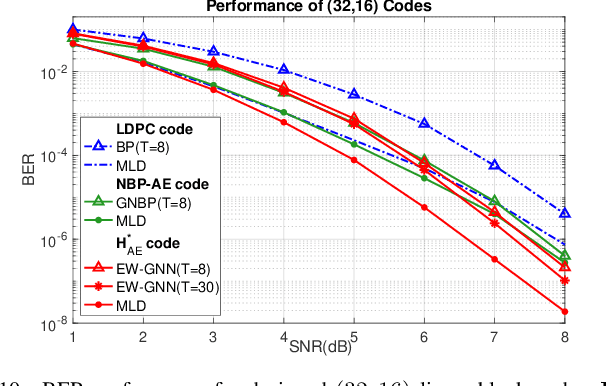
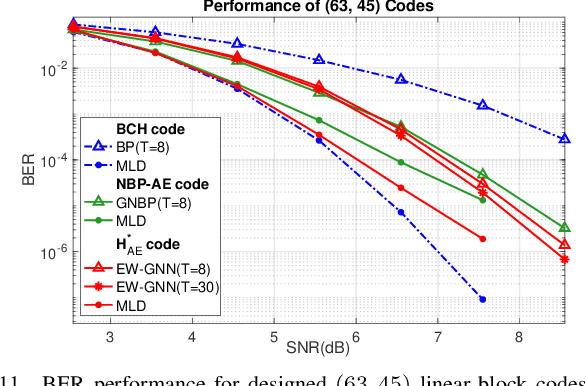
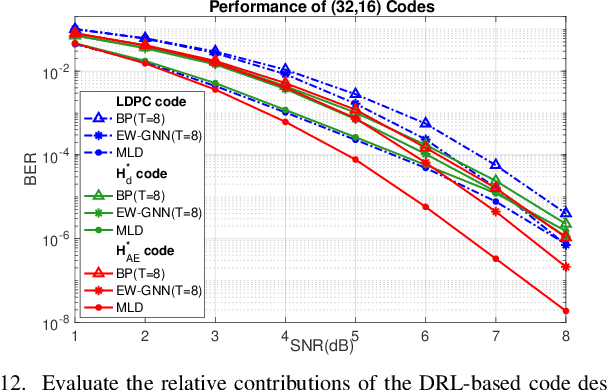
Abstract:This paper presents a novel auto-encoder based end-to-end channel encoding and decoding. It integrates deep reinforcement learning (DRL) and graph neural networks (GNN) in code design by modeling the generation of code parity-check matrices as a Markov Decision Process (MDP), to optimize key coding performance metrics such as error-rates and code algebraic properties. An edge-weighted GNN (EW-GNN) decoder is proposed, which operates on the Tanner graph with an iterative message-passing structure. Once trained on a single linear block code, the EW-GNN decoder can be directly used to decode other linear block codes of different code lengths and code rates. An iterative joint training of the DRL-based code designer and the EW-GNN decoder is performed to optimize the end-end encoding and decoding process. Simulation results show the proposed auto-encoder significantly surpasses several traditional coding schemes at short block lengths, including low-density parity-check (LDPC) codes with the belief propagation (BP) decoding and the maximum-likelihood decoding (MLD), and BCH with BP decoding, offering superior error-correction capabilities while maintaining low decoding complexity.
Wireless Human-Machine Collaboration in Industry 5.0
Oct 21, 2024Abstract:Wireless Human-Machine Collaboration (WHMC) represents a critical advancement for Industry 5.0, enabling seamless interaction between humans and machines across geographically distributed systems. As the WHMC systems become increasingly important for achieving complex collaborative control tasks, ensuring their stability is essential for practical deployment and long-term operation. Stability analysis certifies how the closed-loop system will behave under model randomness, which is essential for systems operating with wireless communications. However, the fundamental stability analysis of the WHMC systems remains an unexplored challenge due to the intricate interplay between the stochastic nature of wireless communications, dynamic human operations, and the inherent complexities of control system dynamics. This paper establishes a fundamental WHMC model incorporating dual wireless loops for machine and human control. Our framework accounts for practical factors such as short-packet transmissions, fading channels, and advanced HARQ schemes. We model human control lag as a Markov process, which is crucial for capturing the stochastic nature of human interactions. Building on this model, we propose a stochastic cycle-cost-based approach to derive a stability condition for the WHMC system, expressed in terms of wireless channel statistics, human dynamics, and control parameters. Our findings are validated through extensive numerical simulations and a proof-of-concept experiment, where we developed and tested a novel wireless collaborative cart-pole control system. The results confirm the effectiveness of our approach and provide a robust framework for future research on WHMC systems in more complex environments.
Communication-Control Codesign for Large-Scale Wireless Networked Control Systems
Oct 15, 2024



Abstract:Wireless Networked Control Systems (WNCSs) are essential to Industry 4.0, enabling flexible control in applications, such as drone swarms and autonomous robots. The interdependence between communication and control requires integrated design, but traditional methods treat them separately, leading to inefficiencies. Current codesign approaches often rely on simplified models, focusing on single-loop or independent multi-loop systems. However, large-scale WNCSs face unique challenges, including coupled control loops, time-correlated wireless channels, trade-offs between sensing and control transmissions, and significant computational complexity. To address these challenges, we propose a practical WNCS model that captures correlated dynamics among multiple control loops with spatially distributed sensors and actuators sharing limited wireless resources over multi-state Markov block-fading channels. We formulate the codesign problem as a sequential decision-making task that jointly optimizes scheduling and control inputs across estimation, control, and communication domains. To solve this problem, we develop a Deep Reinforcement Learning (DRL) algorithm that efficiently handles the hybrid action space, captures communication-control correlations, and ensures robust training despite sparse cross-domain variables and floating control inputs. Extensive simulations show that the proposed DRL approach outperforms benchmarks and solves the large-scale WNCS codesign problem, providing a scalable solution for industrial automation.
Secure Enhancement for RIS-Aided UAV with ISAC: Robust Design and Resource Allocation
Sep 25, 2024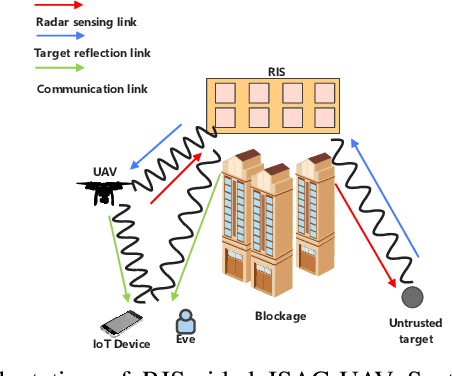

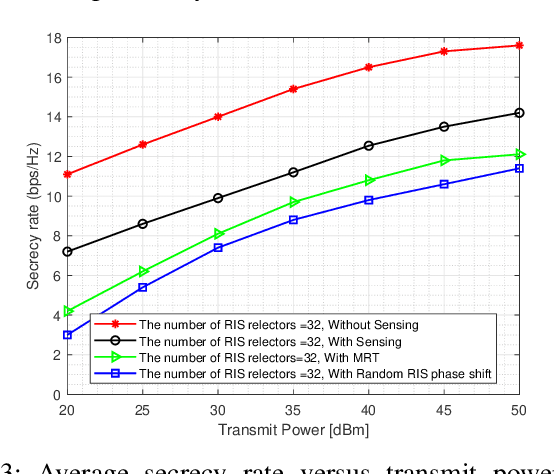

Abstract:This paper analyses the security performance of a reconfigurable intelligent surface (RIS)-aided unmanned aerial vehicle (UAV) communication system with integrated sensing and communications (ISAC). We consider a multiple-antenna UAV transmitting ISAC waveforms to simultaneously detect an untrusted target in the surrounding environment and communicate with a ground Internet-of-Things (IoT) device in the presence of an eavesdropper (Eve). Given that the Eve can conceal their channel state information (CSI) in practical scenarios, we assume that the CSI of the eavesdropper channel is imperfect. For this RIS-aided ISAC-UAV system, we aim to maximize the average communication secrecy rate by jointly optimizing UAV trajectory, RIS passive beamforming, transmit beamforming, and receive beamforming. However, this joint optimization problem is non-convex due to multi-variable coupling. As such, we solve the optimization using an efficient and tractable algorithm using a block coordinate descent (BCD) method. Specifically, we develop a successive convex approximation (SCA) algorithm based on semidefinite relaxation (SDR) to optimise the joint optimization as four separate non-convex subproblems. Numerical results show that our proposed algorithm can successfully ensure the accuracy of sensing targets and significantly improve the communication secrecy rate of the IoT communication devices.
Movable Antenna Enabled ISAC Beamforming Design for Low-Altitude Airborne Vehicles
Sep 24, 2024Abstract:In mobile systems with low-altitude vehicles, integrated sensing and communication (ISAC) is considered an effective approach to increase the transmission rate due to limited spectrum resources. To further improve the ISAC performance, this paper proposes a novel method called integrated sensing and communication-movable antenna (ISAC-MA) to optimize the antenna's position. Our goal is to support low-space vehicles by optimizing radar and communication joint beamforming and antenna position in the presence of clutter. This scheme not only guarantees the required signal-to-noise ratio (SNR) for sensing but also further improves the SNR for communication. A successive convex approximation (SCA)-based block coordinate descent (BCD) algorithm is proposed to maximize communication capacity under the condition of sensing SNR. Numerical results show that, compared with the traditional ISAC system and various benchmark schemes, the proposed ISAC-MA system can achieve higher communication capacity under the same sensing SNR constraints.
Improving Physical-Layer Security in ISAC-UAV System: Beamforming and Trajectory Optimization
Sep 22, 2024



Abstract:This paper investigates a novel unmanned aerial vehicle (UAV) secure communication system with integrated sensing and communications. We consider wireless security enhancement for a multiple-antenna UAV transmitting ISAC waveforms to communicate with multiple ground Internet-of-Thing devices and detect the surrounding environment. Specifically, we aim to maximize the average communication secrecy rate by optimizing the UAV trajectory and beamforming vectors. Given that the UAV trajectory optimization problem is non-convex due to multi-variable coupling develop an efficient algorithm based on the successive convex approximation (SCA) algorithm. Numerical results show that our proposed algorithm can ensure the accuracy of sensing targets and improve the communication secrecy rate.
 Add to Chrome
Add to Chrome Add to Firefox
Add to Firefox Add to Edge
Add to Edge